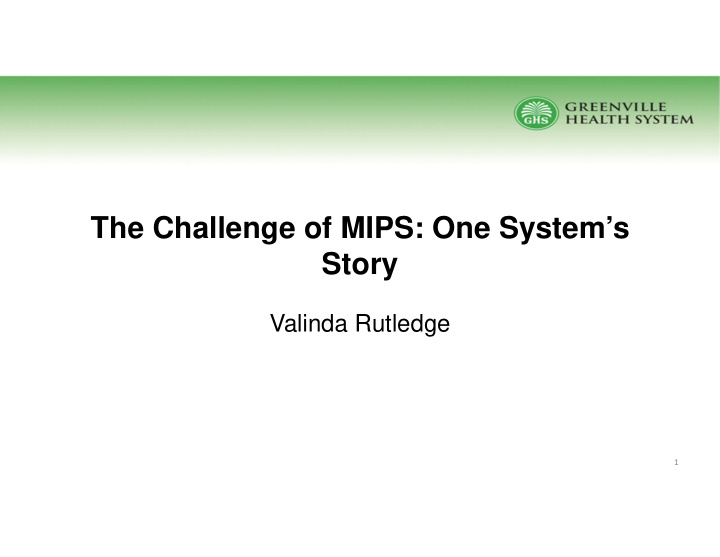



The Challenge of MIPS: One System’s Story Valinda Rutledge 1
South Carolina Health Company: Partnership in South Carolina 2.6M 2.6M Total P tal Popul pulati tion Ac on Access cess (1) (1) 1. 1.2M Unique ique Patie Patients ( ts (FY16) 6) 1,409 409 Empl ployed P ed Physi ysicians ians 1, 1,484 In Independe pendent C t CIN N Physicians ysicians 28,625 28,625 Number of Empl Number of Employees ees 111K 111K Total In tal Inpati patient Discharge Discharges $3.9B $3.9B FY 20 FY 2016 T Tota tal Ope Operat ating R Revenu nue Note: (1) Total population of communities served is inclusive of the historical primary and secondary service areas for both organizations Sources: Definitive Healthcare; Why Not The Best 32% of practices are in Rural areas
Ongoing Rural Challenges in MIPS • EMR vendors require significant upgrade fees and rate increases in order to deliver a product that can track and report MIPS requirements • In quality outcome measures, an absence of risk adjustment does not address an older, sicker, poorer patient population Small practice bonuses provided in MIPS do not level the • playing field in the competition between rural and urban practices, as well as very few aAPMs are applicable to rural providers A lack of connectivity and clinical integration with other • rural providers results in additional challenges for Promoting Interoperability and Cost categories • Running lean for decades, rural practices don’t have available resources to hire additional staff to address MIPS complexities • MIPS implementation costs far exceed the potential for positive adjustments
A Tale of Two Cities-MIPS Negative ROI Once upon a time in a large and sophisticated clinically integrated network… Patients experienced difficulty accessing care while physicians and clinical staff collectively spent countless hours being educated and learning new workflows solely for the purpose of documenting to meet MIPS requirements… Dozens of additional full ‐ time staff worked tens of thousands of hours to provide the education, support, information technology resources, and reporting expertise to meet MIPS requirements… And, in the end, despite achieving a high enough MIPS score to be eligible for the “exceptional performance bonus”, the network physicians received a 1.59% positive payment adjustment which calculated out to be equal to 60% of all costs expended ‐ nowhere near enough to cover the increased expenditure and staff time that could have been dedicated to providing better care instead of checking off MIPS boxes.
A Tale of Two Cities- Advanced APM Positive ROI Once upon a time in a large and sophisticated clinically integrated network… Patients still experienced difficulty accessing care while physicians and clinical staff collectively spent countless hours being educated and learning new workflows for the purpose of learning new competencies to be successful in a risk based environment … Dozens of additional full ‐ time staff worked tens of thousands of hours to provide the education, support, information technology resources, and reporting expertise to learn these new competencies through carefully selecting MIPS variables related to their future success in an Advanced APM … And, in the end, even if the MIPS bonus was minimal, the CIN was dedicated to becoming successful under a population based contract instead of focusing on checking off MIPS boxes. They eventually prevailed with successful shared savings and improved care in multiple multi ‐ payer (public and private) Advanced APM contracts by adoption of these new competences.
Recommend
More recommend